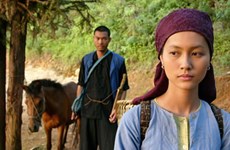Into the arena of Do Son buffalo fighting festival
The buffalo fighting in Do Son Town in Hai Phong City,
recognised as a national intangible cultural heritage on September 12,
is a traditional festival of Vietnam attached to a Water God
worshipping ceremony and the "Hien Sinh" (sacrifice) custom.
The buffalo fighting in Do Son Town in Hai Phong City,
recognised as a national intangible cultural heritage on September 12,
is a traditional festival of Vietnam attached to a Water God
worshipping ceremony and the "Hien Sinh" (sacrifice) custom.
Annually on the ninth day of the eighth lunar month, thousands of people flock to the Do Son stadium to witness the attractive performances of buffaloes within the festival, an outstanding and unique in Vietnam which is associated with different legends.
One of the legends has it that long time ago, one Creator caused a severe drought. All living things looked toward the sea, praying for Creator’s favour. In the most miserable moment, suddenly people saw two buffaloes fighting fiercely on the wave crests and the rains started to pour down, reviving all creatures.
Local people organise the fighting performance annually to show not only their gratitude for Sir Buffalo but also their desire for the immortal vitality and strength of coastal people of Hai Phong. Held officially and annually since the 18th century, the festival is a chance for local people to pray for prosperity and happiness.
The preparation for festival is an elaborate process, as early as from the 5th and the 6th lunar months. The competing buffaloes must be carefully selected and methodically trained months in advance. The animals, going through the qualifying round, must be between 4 and 5 years old, with a good appearance, a wide chest, a big groin, a long neck, an acute bottom and bow shaped horns.
During the training, the buffaloes are well-fed and kept away from all other animals. Many locals pick their favourite before the actual fight, and some even hold prayers the night before to wish their chosen creature good luck.
When the day of the festival finally arrives, a large and colourful procession is led down the streets and the chosen buffaloes, covered with red cloth and red band around their horns, are taken to the ring by 24 young men, from each side dressed in red.
The young men dance to the ebullient sounds of drums and gongs and wave flags as the two teams of troops take their positions, bringing a hectic atmosphere to the festival. After that, a pair of buffaloes are led to opposite sides of the ring and made to stand near two flags called "Ngu Phung".
Upon the first signal, the two are taken to the fighting circle. When the second signal chimes, the animals are unleashed as the spectators yell and cheer. Butting heads, they can fight for even hours.
With well-practiced movements, the buffaloes rush to each other, using their fighting skills to decide the right to enter the next match while the spectators shout and urge the fighting along. Then, the winning animal goes to the next round till the final winner emerges. The matches vary in length, depending on the strength and stamina of the buffaloes.
At the completion of the fight, the spectacle of "receiving the buffaloes" is very interesting as organisers must then catch the winning buffalo to hand its reward. The owner of the winning creature will receive 40 million VND, or almost 2,000 USD. Typically, villagers of the prize-winning buffalo will celebrate its victory for the rest of the evening, often bringing the creature along for the party.
However, winning or losing, every participating buffalo is slaughtered and its meat sold right outside the stadium. Buyers believe that it will bring them good luck.
In recent years, this traditional festival, which attracts not only local residents but also thousands of domestic and international tourists, demonstrates the martial spirit of the local people as well as helps promote the locality's image and tourism potential.-VNA
Annually on the ninth day of the eighth lunar month, thousands of people flock to the Do Son stadium to witness the attractive performances of buffaloes within the festival, an outstanding and unique in Vietnam which is associated with different legends.
One of the legends has it that long time ago, one Creator caused a severe drought. All living things looked toward the sea, praying for Creator’s favour. In the most miserable moment, suddenly people saw two buffaloes fighting fiercely on the wave crests and the rains started to pour down, reviving all creatures.
Local people organise the fighting performance annually to show not only their gratitude for Sir Buffalo but also their desire for the immortal vitality and strength of coastal people of Hai Phong. Held officially and annually since the 18th century, the festival is a chance for local people to pray for prosperity and happiness.
The preparation for festival is an elaborate process, as early as from the 5th and the 6th lunar months. The competing buffaloes must be carefully selected and methodically trained months in advance. The animals, going through the qualifying round, must be between 4 and 5 years old, with a good appearance, a wide chest, a big groin, a long neck, an acute bottom and bow shaped horns.
During the training, the buffaloes are well-fed and kept away from all other animals. Many locals pick their favourite before the actual fight, and some even hold prayers the night before to wish their chosen creature good luck.
When the day of the festival finally arrives, a large and colourful procession is led down the streets and the chosen buffaloes, covered with red cloth and red band around their horns, are taken to the ring by 24 young men, from each side dressed in red.
The young men dance to the ebullient sounds of drums and gongs and wave flags as the two teams of troops take their positions, bringing a hectic atmosphere to the festival. After that, a pair of buffaloes are led to opposite sides of the ring and made to stand near two flags called "Ngu Phung".
Upon the first signal, the two are taken to the fighting circle. When the second signal chimes, the animals are unleashed as the spectators yell and cheer. Butting heads, they can fight for even hours.
With well-practiced movements, the buffaloes rush to each other, using their fighting skills to decide the right to enter the next match while the spectators shout and urge the fighting along. Then, the winning animal goes to the next round till the final winner emerges. The matches vary in length, depending on the strength and stamina of the buffaloes.
At the completion of the fight, the spectacle of "receiving the buffaloes" is very interesting as organisers must then catch the winning buffalo to hand its reward. The owner of the winning creature will receive 40 million VND, or almost 2,000 USD. Typically, villagers of the prize-winning buffalo will celebrate its victory for the rest of the evening, often bringing the creature along for the party.
However, winning or losing, every participating buffalo is slaughtered and its meat sold right outside the stadium. Buyers believe that it will bring them good luck.
In recent years, this traditional festival, which attracts not only local residents but also thousands of domestic and international tourists, demonstrates the martial spirit of the local people as well as helps promote the locality's image and tourism potential.-VNA













